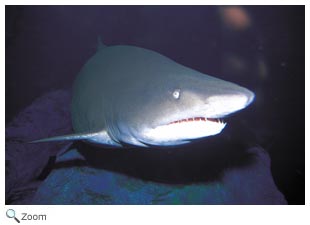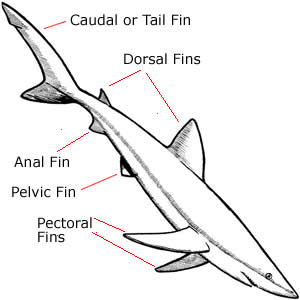 There are around 1,000 species in this class of fish. The species in this class have a flexible skeleton made of cartilage instead of bone. There are around 1,000 species in this class of fish. The species in this class have a flexible skeleton made of cartilage instead of bone.
Cartilage is the flexible substance found that gives human noses and ears their shape! Only their teeth, and sometimes their
vertebrae,
have calcium in them! That why when you find fossils of sharks you find teeth and vertebrae but no other bones.
Species in this class have paired fins, hard scales, a two-chambered heart, and a pair of nostrils. Most species have 5-7 gill slits on each side of their body. Some species produce egg cases, others give birth to live young.
Sharks swim by moving their heads and tails from side to side in the water. They use fins to stabilize themselves when they swim, to steer themselves in the water or to propel themselves through the water. Sharks have fins on their back, sides, and stomachs.
 The fins on their back are called dorsal fins. Some species have one dorsal fin and others have two dorsal fins. In some species, the dorsal fin has a stiff spine, and in other species, there is no spine. There are even some species that have a poisonous spine on their dorsal fins. Dorsal fins help keep sharks from rolling over in the water! The fins on their back are called dorsal fins. Some species have one dorsal fin and others have two dorsal fins. In some species, the dorsal fin has a stiff spine, and in other species, there is no spine. There are even some species that have a poisonous spine on their dorsal fins. Dorsal fins help keep sharks from rolling over in the water!
The fins on the side of a shark are the pectoral fins. Pectoral fins are used for steering and to give the shark lift in the water. The pelvic fin is found on the shark's stomach. It is used to stabilize the shark in the water. In male sharks, there may be an organ on them called a
clasper that is used during mating. The anal fin is found on the underside of the shark at the base of the tail. It is not found on all sharks. The anal fin is also used for stabilization.
The tail, or caudal fin, has a top and bottom part. The two parts may look nothing alike and can be different shapes and sizes. The caudal fin is used to propel the shark through the water.
|
 Carcharhiniformes (ground sharks)
Carcharhiniformes (ground sharks) Chimaeriformes (chimaeras)
Chimaeriformes (chimaeras) Heterodontiformes (bullhead sharks)
Heterodontiformes (bullhead sharks)  Hexanchiformes (cow sharks, frilled sharks)
Hexanchiformes (cow sharks, frilled sharks)  Lamniformes (mackerel sharks)
Lamniformes (mackerel sharks)  Orectolobiformes (carpet sharks)
Orectolobiformes (carpet sharks)  Pristiophoriformes (saw sharks)
Pristiophoriformes (saw sharks)  Rajiformes (rays, sawfishes, skates)
Rajiformes (rays, sawfishes, skates)  Squaliformes (sleeper sharks, dogfish sharks)
Squaliformes (sleeper sharks, dogfish sharks) Squatiniformes (angelsharks)
Squatiniformes (angelsharks) 

 The fins on their back are called dorsal fins. Some species have one dorsal fin and others have two dorsal fins. In some species, the dorsal fin has a stiff spine, and in other species, there is no spine. There are even some species that have a poisonous spine on their dorsal fins. Dorsal fins help keep sharks from rolling over in the water!
The fins on their back are called dorsal fins. Some species have one dorsal fin and others have two dorsal fins. In some species, the dorsal fin has a stiff spine, and in other species, there is no spine. There are even some species that have a poisonous spine on their dorsal fins. Dorsal fins help keep sharks from rolling over in the water!